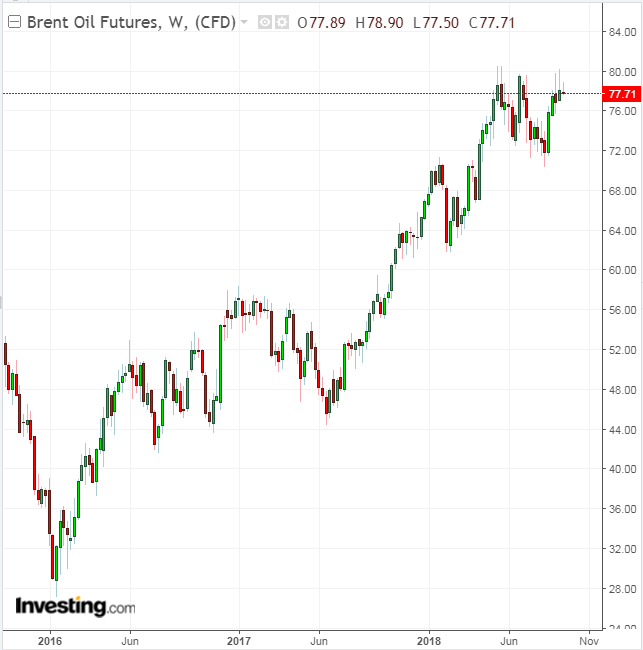The world awaits November 3 for a new age of high oil prices under Donald Trump, as he attempts to wipe out Iranian crude exports from the market. That era might arrive sooner than most think, energy research firms and investment banks say.
Supply shortages stemming from the Iranian oil crisis are already forcing refiners to switch from the less-costly “sour,” or sulfur-heavy, crudes to the “sweet” but more expensive light oils, they add. “It’s time for the sweets to rise … and for the sours to pause for breath,” researchers at Energy Aspects, a London-based consultancy, said in a note on Monday as global crude oil benchmark Brent remained within striking distance this week of a 3-1/2 year high above $80 a barrel that it hit in May.

Hard To Keep Prices Down For Long
Trump wants to punish Iran but at the same time prevent a global oil price spike from hitting home. He hopes to achieve that by selling crude from the US Strategic Petroleum Reserve.
But the researchers at Energy Aspects said that even with a SPR sale, or tweet by the president of his intent to sell from the reserves, “it will be hard to keep prices down for long.” They added:
“The current physical market looks the tightest it has in years.”
Sweet or light crudes contain less than 0.5 percent sulfur and are ideal for producing gasoline, kerosene and high-grade diesel. The US West Texas Intermediate is one the world’s foremost light crudes, with a sulfur content of 0.24 percent. Brent is a medium-grade sweet, with 0.37 percent sulfur.
Sour or heavy crudes, such as Mexico’s Maya, have sulfur content that can go up to 3.5 percent. Such crudes also have impurities that need to be removed before they can be turned into other petroleum products, adding to refining costs. To make them economically viable, refiners sometimes turn these crudes into lower-grade diesel and fuel oils that require less processing but have larger mass markets.
Iran mainly produces medium and heavy sour crudes.
India, China Slashing Iranian Purchases
Researchers at Energy Aspects said Iran’s crude exports were falling fast and could reach below 1.0 million barrels per day (bpd) by November as India and China appeared to be buying less from the Islamic state than thought. Before the cutbacks began, Iran’s crude shipments stood as high as 2.4 million bpd in May, making it the sixth largest oil exporter.
“Our base case is still for Indian imports of Iranian crude to fall by at least 50 percent, but there is a growing possibility that, unless the Trump Administration issues waivers soon, Indian refiners may not lift any Iranian crude in October and November,” the researchers at Energy Aspects said, citing figures from India’s Bharat Petroleum Corp Ltd (NS:BPCL). India had imported as much as 658,000 bpd from Iran between April and August.
China, with its ongoing trade war with the United States, loaded 600,000 bpd of Iranian oil in August – down from the 710,000 bpd averaged between February and June, but still more aggressive than India. Going forward, “that number will likely end up well below August levels, and we understand that October and November loadings could fall substantially,” the researchers at Energy Aspects said.
Buying Crudes That Aren’t Part Of Their Usual Diet
China has also been sourcing medium sour crude from other destinations as alternative, they said. But Saudi Arabia and other members of the Organization of the Petroleum Exporting Countries (OPEC) haven’t added as much to their production of such crudes to make up the deficit in Iranian supply.
“This means refiners will have to buy whatever crude they can get their hands on,” the researchers added. “Physical crude traders suggest that some refiners are already buying crudes that are not part of their usual diet.”
Goldman Sachs, Wall Street’s closely-followed forecaster of oil prices and trends, said the supply disruptions in Iran as well as OPEC member Venezuela – which is in the throes of an economic meltdown – were key to moving Brent into and above the $80 per barrel region. In a note last week, analysts for Goldman's global energy division said:
“We continue to see oil inventories slightly below the 5-year average in 2019, assuming slight acceleration in demand growth, more meaningful acceleration in disruptions.”
Bank of America Merrill Lynch said even if emerging markets’ demand for oil fell by 100,000 to 300,000 bpd, the tightening supply of sour crudes will be a bigger worry.
“The collapse in Venezuelan oil production has taken out 800,000 bpd from the crude oil market in the last 18 months. More recently, Iranian crude oil export loadings seem to have declined by 580,000 bpd in the past three months. Plus, US shale supply is unlikely to grow as fast over the coming months due to a lack of pipeline capacity,” analysts at Bofa-Merrill Lynch said in a note issued Monday.
